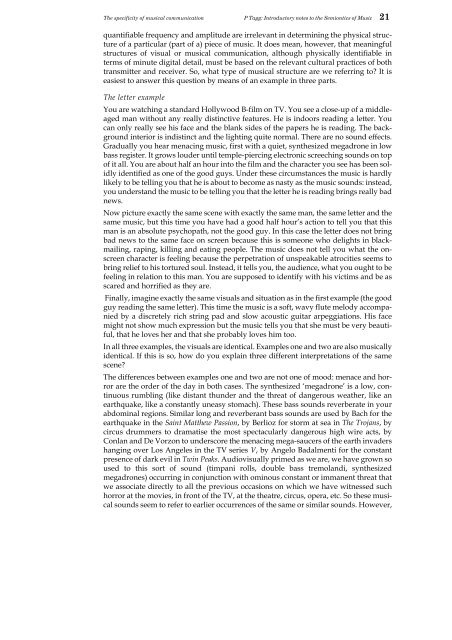Introductory notes to the Semiotics of Music - Philip Tagg's home page
Introductory notes to the Semiotics of Music - Philip Tagg's home page
Introductory notes to the Semiotics of Music - Philip Tagg's home page
You also want an ePaper? Increase the reach of your titles
YUMPU automatically turns print PDFs into web optimized ePapers that Google loves.
The specificity <strong>of</strong> musical communication P Tagg: <strong>Introduc<strong>to</strong>ry</strong> <strong>notes</strong> <strong>to</strong> <strong>the</strong> Semiontics <strong>of</strong> <strong>Music</strong> 21<br />
quantifiable frequency and amplitude are irrelevant in determining <strong>the</strong> physical structure<br />
<strong>of</strong> a particular (part <strong>of</strong> a) piece <strong>of</strong> music. It does mean, however, that meaningful<br />
structures <strong>of</strong> visual or musical communication, although physically identifiable in<br />
terms <strong>of</strong> minute digital detail, must be based on <strong>the</strong> relevant cultural practices <strong>of</strong> both<br />
transmitter and receiver. So, what type <strong>of</strong> musical structure are we referring <strong>to</strong>? It is<br />
easiest <strong>to</strong> answer this question by means <strong>of</strong> an example in three parts.<br />
The letter example<br />
You are watching a standard Hollywood B-film on TV. You see a close-up <strong>of</strong> a middleaged<br />
man without any really distinctive features. He is indoors reading a letter. You<br />
can only really see his face and <strong>the</strong> blank sides <strong>of</strong> <strong>the</strong> papers he is reading. The background<br />
interior is indistinct and <strong>the</strong> lighting quite normal. There are no sound effects.<br />
Gradually you hear menacing music, first with a quiet, syn<strong>the</strong>sized megadrone in low<br />
bass register. It grows louder until temple-piercing electronic screeching sounds on <strong>to</strong>p<br />
<strong>of</strong> it all. You are about half an hour in<strong>to</strong> <strong>the</strong> film and <strong>the</strong> character you see has been solidly<br />
identified as one <strong>of</strong> <strong>the</strong> good guys. Under <strong>the</strong>se circumstances <strong>the</strong> music is hardly<br />
likely <strong>to</strong> be telling you that he is about <strong>to</strong> become as nasty as <strong>the</strong> music sounds: instead,<br />
you understand <strong>the</strong> music <strong>to</strong> be telling you that <strong>the</strong> letter he is reading brings really bad<br />
news.<br />
Now picture exactly <strong>the</strong> same scene with exactly <strong>the</strong> same man, <strong>the</strong> same letter and <strong>the</strong><br />
same music, but this time you have had a good half hour’s action <strong>to</strong> tell you that this<br />
man is an absolute psychopath, not <strong>the</strong> good guy. In this case <strong>the</strong> letter does not bring<br />
bad news <strong>to</strong> <strong>the</strong> same face on screen because this is someone who delights in blackmailing,<br />
raping, killing and eating people. The music does not tell you what <strong>the</strong> onscreen<br />
character is feeling because <strong>the</strong> perpetration <strong>of</strong> unspeakable atrocities seems <strong>to</strong><br />
bring relief <strong>to</strong> his <strong>to</strong>rtured soul. Instead, it tells you, <strong>the</strong> audience, what you ought <strong>to</strong> be<br />
feeling in relation <strong>to</strong> this man. You are supposed <strong>to</strong> identify with his victims and be as<br />
scared and horrified as <strong>the</strong>y are.<br />
Finally, imagine exactly <strong>the</strong> same visuals and situation as in <strong>the</strong> first example (<strong>the</strong> good<br />
guy reading <strong>the</strong> same letter). This time <strong>the</strong> music is a s<strong>of</strong>t, wavy flute melody accompanied<br />
by a discretely rich string pad and slow acoustic guitar arpeggiations. His face<br />
might not show much expression but <strong>the</strong> music tells you that she must be very beautiful,<br />
that he loves her and that she probably loves him <strong>to</strong>o.<br />
In all three examples, <strong>the</strong> visuals are identical. Examples one and two are also musically<br />
identical. If this is so, how do you explain three different interpretations <strong>of</strong> <strong>the</strong> same<br />
scene?<br />
The differences between examples one and two are not one <strong>of</strong> mood: menace and horror<br />
are <strong>the</strong> order <strong>of</strong> <strong>the</strong> day in both cases. The syn<strong>the</strong>sized ‘megadrone’ is a low, continuous<br />
rumbling (like distant thunder and <strong>the</strong> threat <strong>of</strong> dangerous wea<strong>the</strong>r, like an<br />
earthquake, like a constantly uneasy s<strong>to</strong>mach). These bass sounds reverberate in your<br />
abdominal regions. Similar long and reverberant bass sounds are used by Bach for <strong>the</strong><br />
earthquake in <strong>the</strong> Saint Mat<strong>the</strong>w Passion, by Berlioz for s<strong>to</strong>rm at sea in The Trojans, by<br />
circus drummers <strong>to</strong> dramatise <strong>the</strong> most spectacularly dangerous high wire acts, by<br />
Conlan and De Vorzon <strong>to</strong> underscore <strong>the</strong> menacing mega-saucers <strong>of</strong> <strong>the</strong> earth invaders<br />
hanging over Los Angeles in <strong>the</strong> TV series V, by Angelo Badalmenti for <strong>the</strong> constant<br />
presence <strong>of</strong> dark evil in Twin Peaks. Audiovisually primed as we are, we have grown so<br />
used <strong>to</strong> this sort <strong>of</strong> sound (timpani rolls, double bass tremolandi, syn<strong>the</strong>sized<br />
megadrones) occurring in conjunction with ominous constant or immanent threat that<br />
we associate directly <strong>to</strong> all <strong>the</strong> previous occasions on which we have witnessed such<br />
horror at <strong>the</strong> movies, in front <strong>of</strong> <strong>the</strong> TV, at <strong>the</strong> <strong>the</strong>atre, circus, opera, etc. So <strong>the</strong>se musical<br />
sounds seem <strong>to</strong> refer <strong>to</strong> earlier occurrences <strong>of</strong> <strong>the</strong> same or similar sounds. However,














